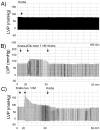Serpinins: role in granule biogenesis, inhibition of cell death and cardiac function
- PMID: 22834799
- PMCID: PMC4826038
- DOI: 10.2174/092986712802429957
Serpinins: role in granule biogenesis, inhibition of cell death and cardiac function
Abstract
Serpinins are a family of peptides derived from proteolytic cleavage of the penultimate and the last pair of basic residues at the C-terminus of Chromogranin A. Three forms of naturally occurring serpinin have been found in AtT-20 pituitary cells and rat heart. They are serpinin, pyrogutaminated (pGlu) -serpinin and a C-terminally extended form, serpinin-RRG. In addition pGlu-serpinin has been found in brain, primarily in neurites and nerve terminals and shown to have protective effects against oxidative stress on neurons and pituitary cells. Serpinin has also been demonstrated to regulate granule biogenesis in endocrine cells by up-regulating the protease inhibitor, protease nexin-1 transcription via a cAMP-PKA-sp1 pathway. This leads to inhibition of granule protein degradation in the Golgi complex which in turn promotes granule formation. More recently, pGlu-serpinin has been demonstrated to enhance both myocardial contractility (inotropy) and relaxation (lusitropy). In the Langendorff perfused rat heart, pGlu-serpinin showed a concentration-dependent positive inotropic effect exerted through a cAMP-PKA dependent pathway. In conclusion, the serpinin peptides have profound effects at many levels that affect the endocrine and nervous systems and cardiac function.
Figures






References
Publication types
MeSH terms
Substances
Grants and funding
LinkOut - more resources
Full Text Sources
Research Materials

